FORD EXPEDITION 1997 1.G Owners Manual
Manufacturer: FORD, Model Year: 1997, Model line: EXPEDITION, Model: FORD EXPEDITION 1997 1.GPages: 224, PDF Size: 2.2 MB
Page 171 of 224

CHECKING AND ADDING
TRANSMISSION FLUID
Checking and adding automatic
transmission fluid (if equipped)
Service the automatic transmission
according to the scheduled
intervals in the9Service Guide.9
Before adding any fluid, make sure
the correct type will be used. This
information is indicated on the
dipstick.
²4R7OW automatic transmissions
are used with 4.6 L engine
applications.
²E4OD automatic transmissions
are used with 5.4 L engine
applications.
Do not drive the vehicle if the fluid
level is below the bottom hole on
the blade type dipstick (4R70W
transmission) or below the COLD
area on the bullet type dipstick
(E4OD transmission) and outside
temperatures are above 10ÉC
(50ÉF).
Your vehicle does not use up
transmission fluid. However, it is
recommended that you check the
transmission fluid at least twice a
year. The fluid level should be
checked if the transmission is not
working properly, i.e., if the
transmission slips or shifts slowly
or if you notice some sign of fluid
leakage.
It is preferable to check the
transmission fluid level at normal
operating temperature, afterexd_checking_adding_autotrans
Maintenance and care
172
Page 172 of 224
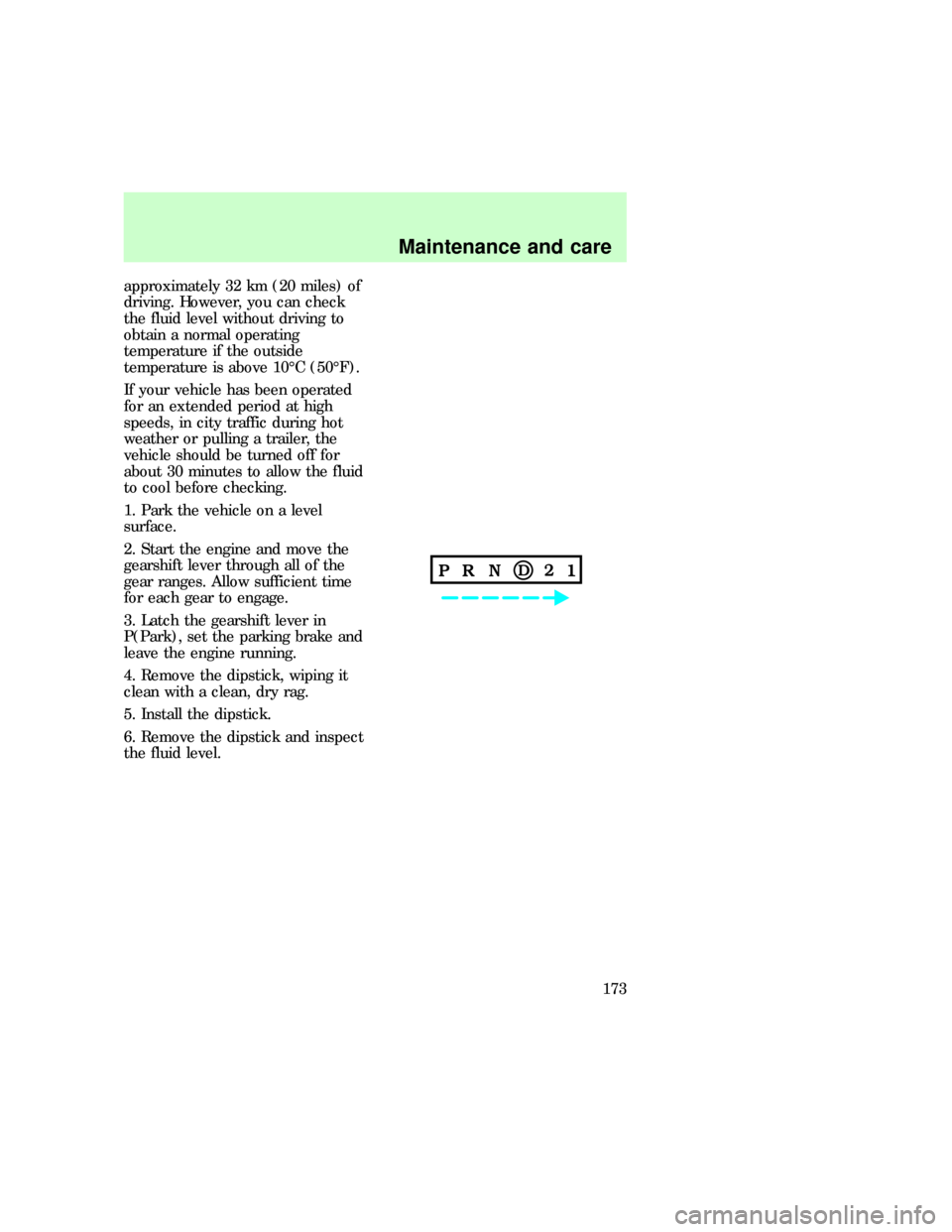
approximately 32 km (20 miles) of
driving. However, you can check
the fluid level without driving to
obtain a normal operating
temperature if the outside
temperature is above 10ÉC (50ÉF).
If your vehicle has been operated
for an extended period at high
speeds, in city traffic during hot
weather or pulling a trailer, the
vehicle should be turned off for
about 30 minutes to allow the fluid
to cool before checking.
1. Park the vehicle on a level
surface.
2. Start the engine and move the
gearshift lever through all of the
gear ranges. Allow sufficient time
for each gear to engage.
3. Latch the gearshift lever in
P(Park), set the parking brake and
leave the engine running.
4. Remove the dipstick, wiping it
clean with a clean, dry rag.
5. Install the dipstick.
6. Remove the dipstick and inspect
the fluid level.
Maintenance and care
173
Page 173 of 224
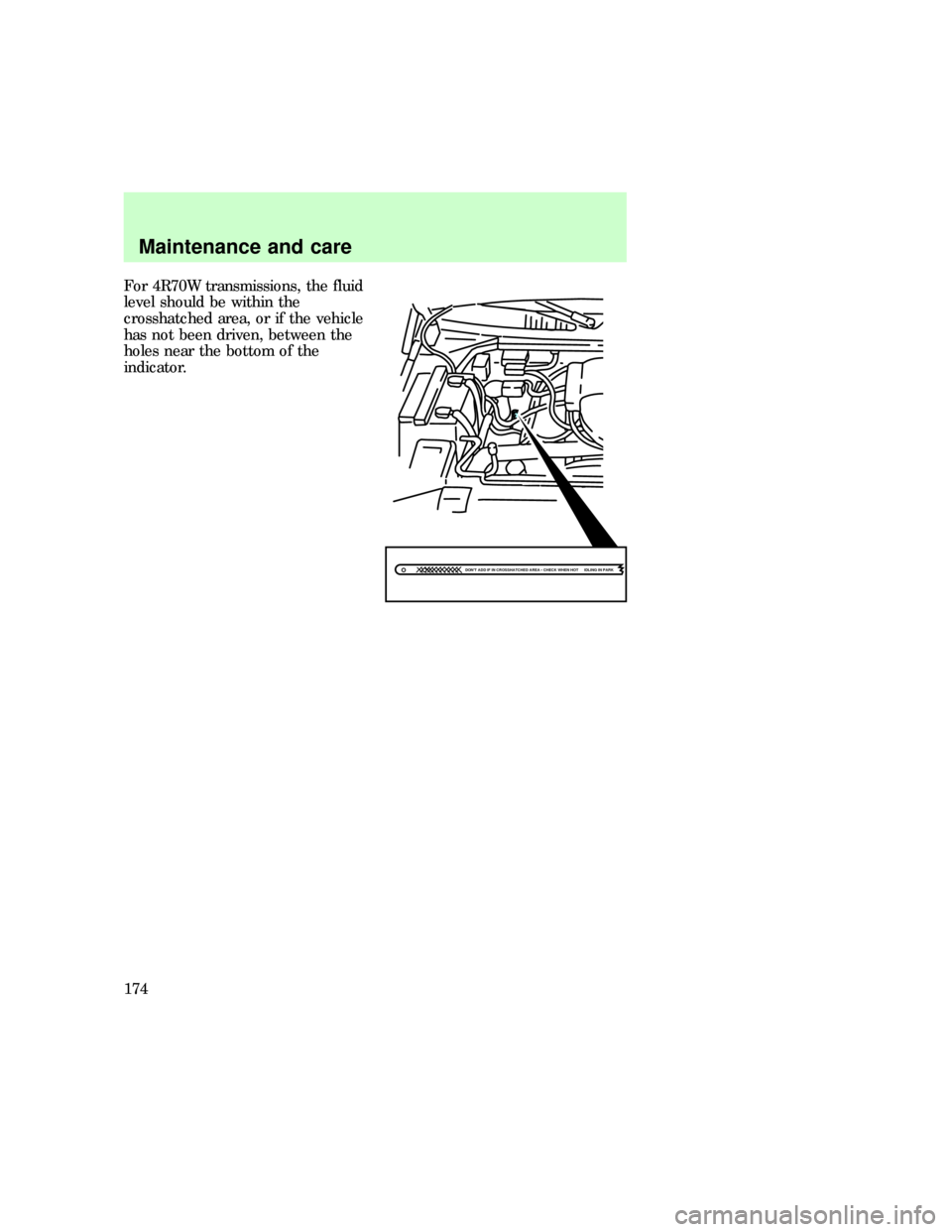
For 4R70W transmissions, the fluid
level should be within the
crosshatched area, or if the vehicle
has not been driven, between the
holes near the bottom of the
indicator.
DON'T ADD IF IN CROSSHATCHED AREA • CHECK WHEN HOT IDLING IN PARK
Maintenance and care
174
Page 174 of 224
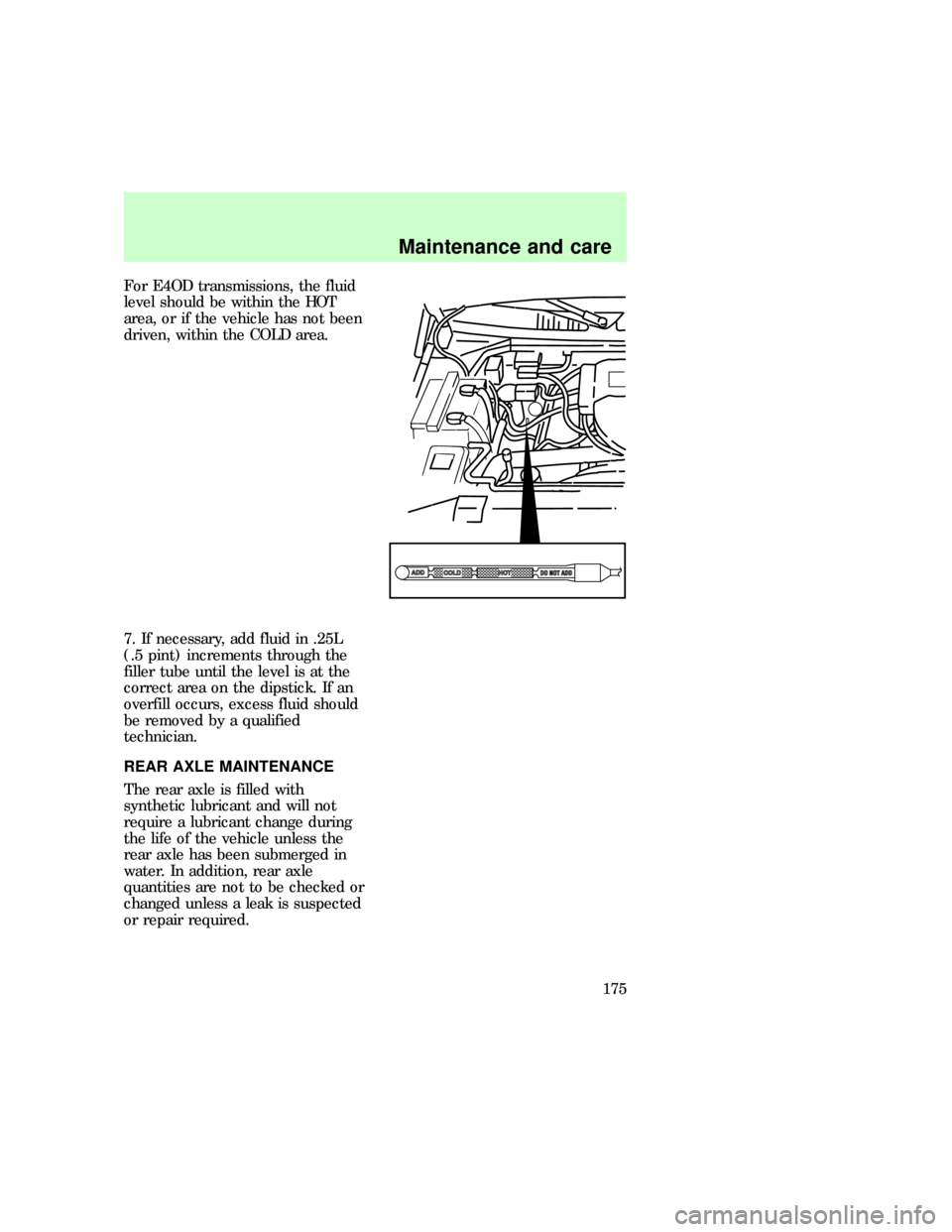
For E4OD transmissions, the fluid
level should be within the HOT
area, or if the vehicle has not been
driven, within the COLD area.
7. If necessary, add fluid in .25L
(.5 pint) increments through the
filler tube until the level is at the
correct area on the dipstick. If an
overfill occurs, excess fluid should
be removed by a qualified
technician.
REAR AXLE MAINTENANCE
The rear axle is filled with
synthetic lubricant and will not
require a lubricant change during
the life of the vehicle unless the
rear axle has been submerged in
water. In addition, rear axle
quantities are not to be checked or
changed unless a leak is suspected
or repair required.
exd_rear_axle
exd_traction_lok
Maintenance and care
175
Page 175 of 224
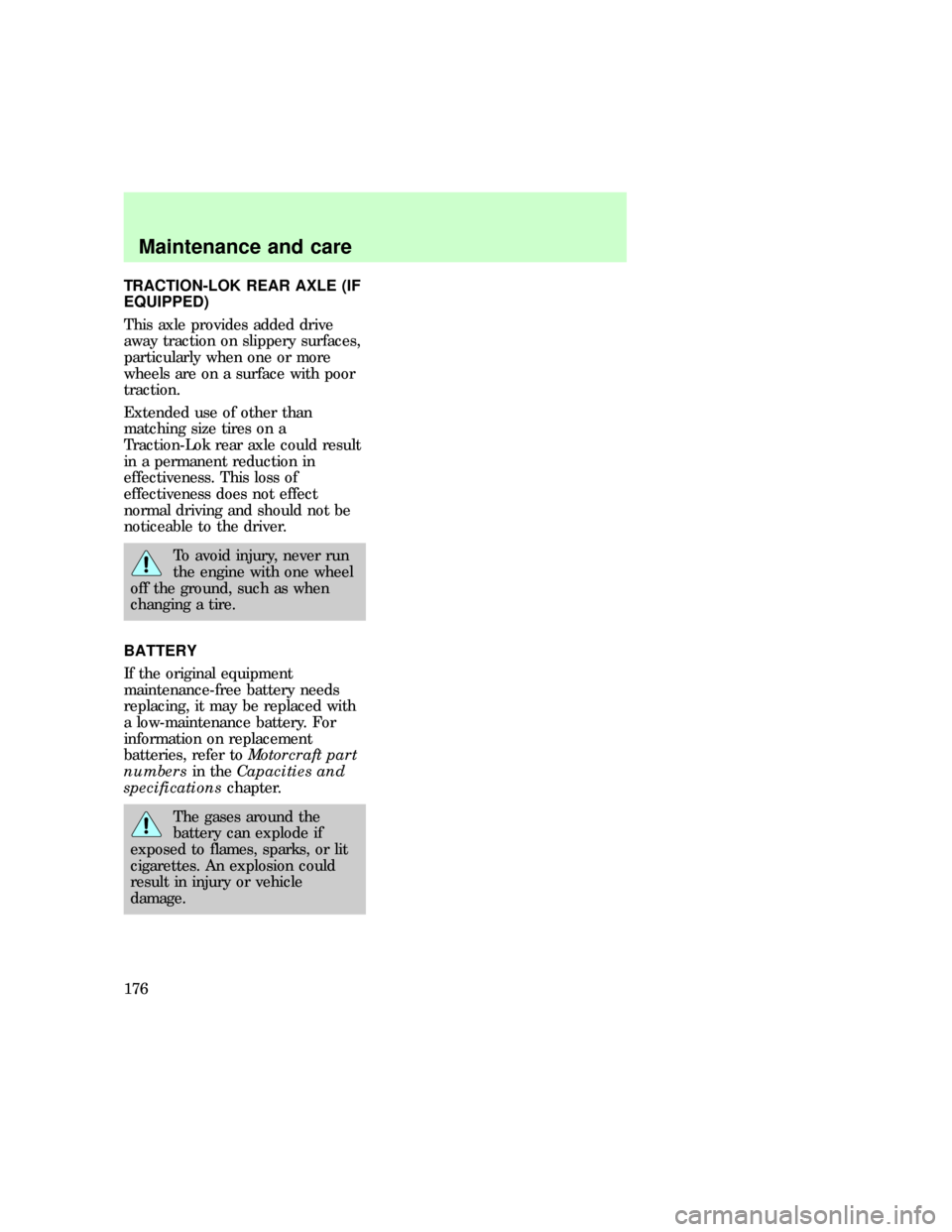
TRACTION-LOK REAR AXLE (IF
EQUIPPED)
This axle provides added drive
away traction on slippery surfaces,
particularly when one or more
wheels are on a surface with poor
traction.
Extended use of other than
matching size tires on a
Traction-Lok rear axle could result
in a permanent reduction in
effectiveness. This loss of
effectiveness does not effect
normal driving and should not be
noticeable to the driver.
To avoid injury, never run
the engine with one wheel
off the ground, such as when
changing a tire.
BATTERY
If the original equipment
maintenance-free battery needs
replacing, it may be replaced with
a low-maintenance battery. For
information on replacement
batteries, refer toMotorcraft part
numbersin theCapacities and
specificationschapter.
The gases around the
battery can explode if
exposed to flames, sparks, or lit
cigarettes. An explosion could
result in injury or vehicle
damage.
exd_battery
Maintenance and care
176
Page 176 of 224
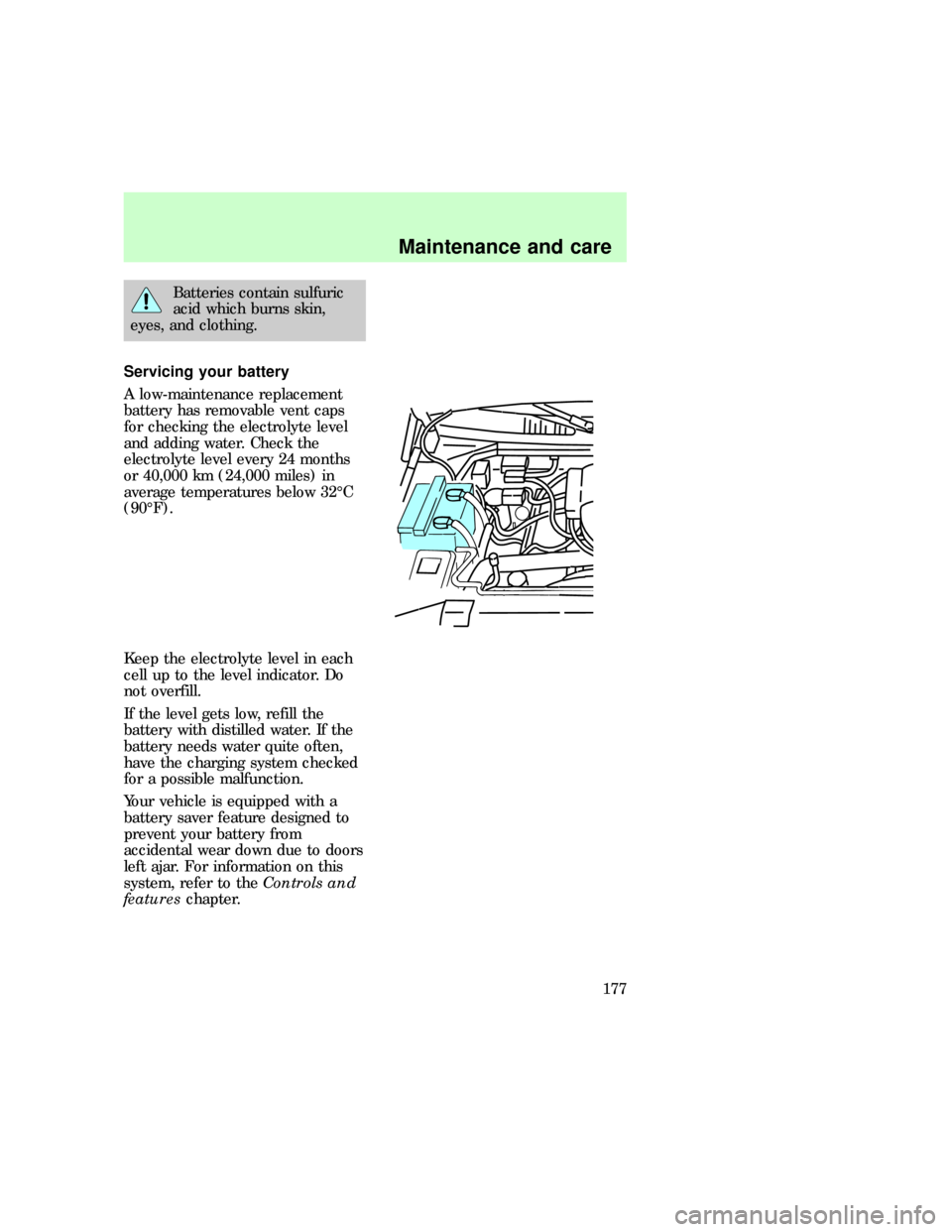
Batteries contain sulfuric
acid which burns skin,
eyes, and clothing.
Servicing your battery
A low-maintenance replacement
battery has removable vent caps
for checking the electrolyte level
and adding water. Check the
electrolyte level every 24 months
or 40,000 km (24,000 miles) in
average temperatures below 32ÉC
(90ÉF).
Keep the electrolyte level in each
cell up to the level indicator. Do
not overfill.
If the level gets low, refill the
battery with distilled water. If the
battery needs water quite often,
have the charging system checked
for a possible malfunction.
Your vehicle is equipped with a
battery saver feature designed to
prevent your battery from
accidental wear down due to doors
left ajar. For information on this
system, refer to theControls and
featureschapter.
exd_servicing_battery
Maintenance and care
177
Page 177 of 224
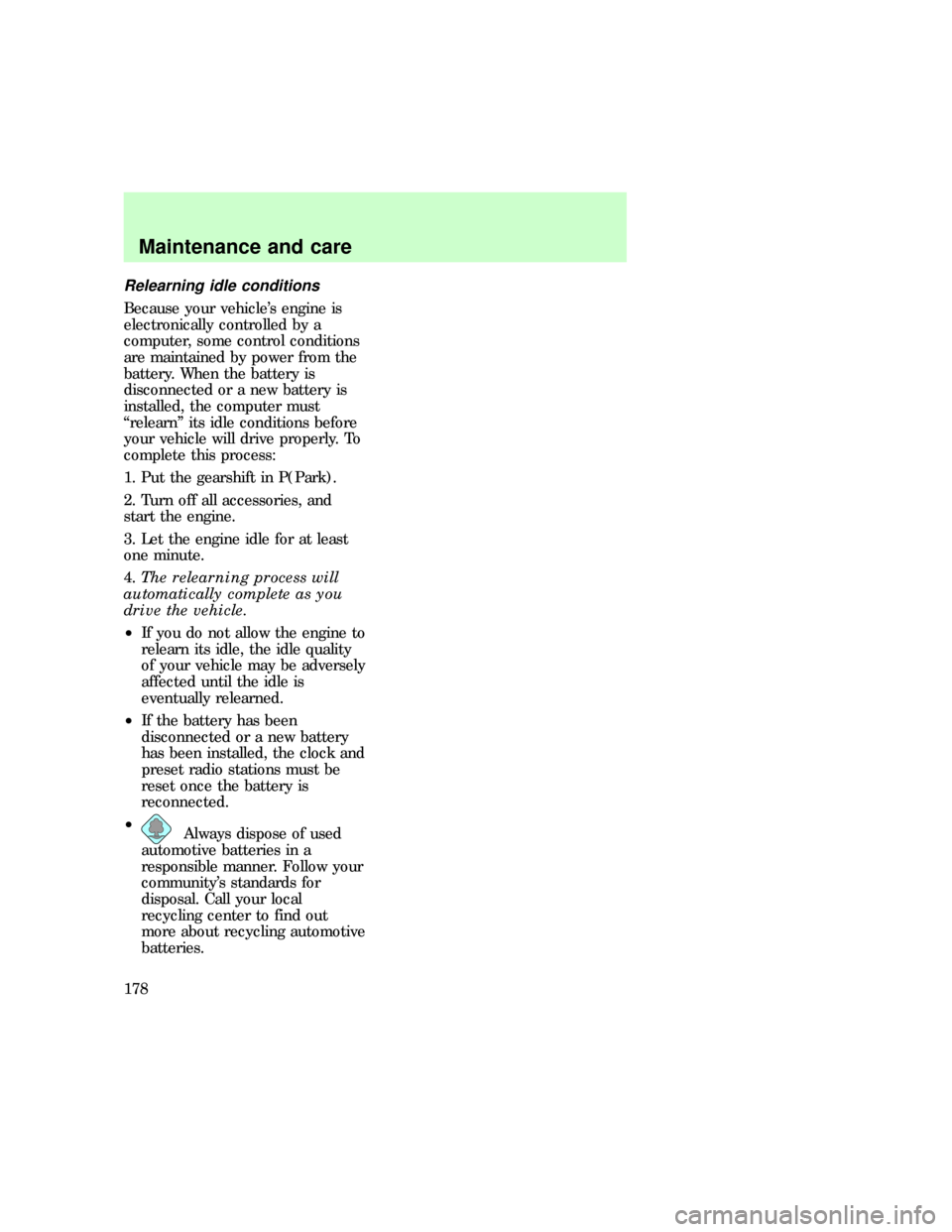
Relearning idle conditions
Because your vehicle's engine is
electronically controlled by a
computer, some control conditions
are maintained by power from the
battery. When the battery is
disconnected or a new battery is
installed, the computer must
ªrelearnº its idle conditions before
your vehicle will drive properly. To
complete this process:
1. Put the gearshift in P(Park).
2. Turn off all accessories, and
start the engine.
3. Let the engine idle for at least
one minute.
4.The relearning process will
automatically complete as you
drive the vehicle.
²If you do not allow the engine to
relearn its idle, the idle quality
of your vehicle may be adversely
affected until the idle is
eventually relearned.
²If the battery has been
disconnected or a new battery
has been installed, the clock and
preset radio stations must be
reset once the battery is
reconnected.
²
Always dispose of used
automotive batteries in a
responsible manner. Follow your
community's standards for
disposal. Call your local
recycling center to find out
more about recycling automotive
batteries.
exd_air-filter
Maintenance and care
178
Page 178 of 224
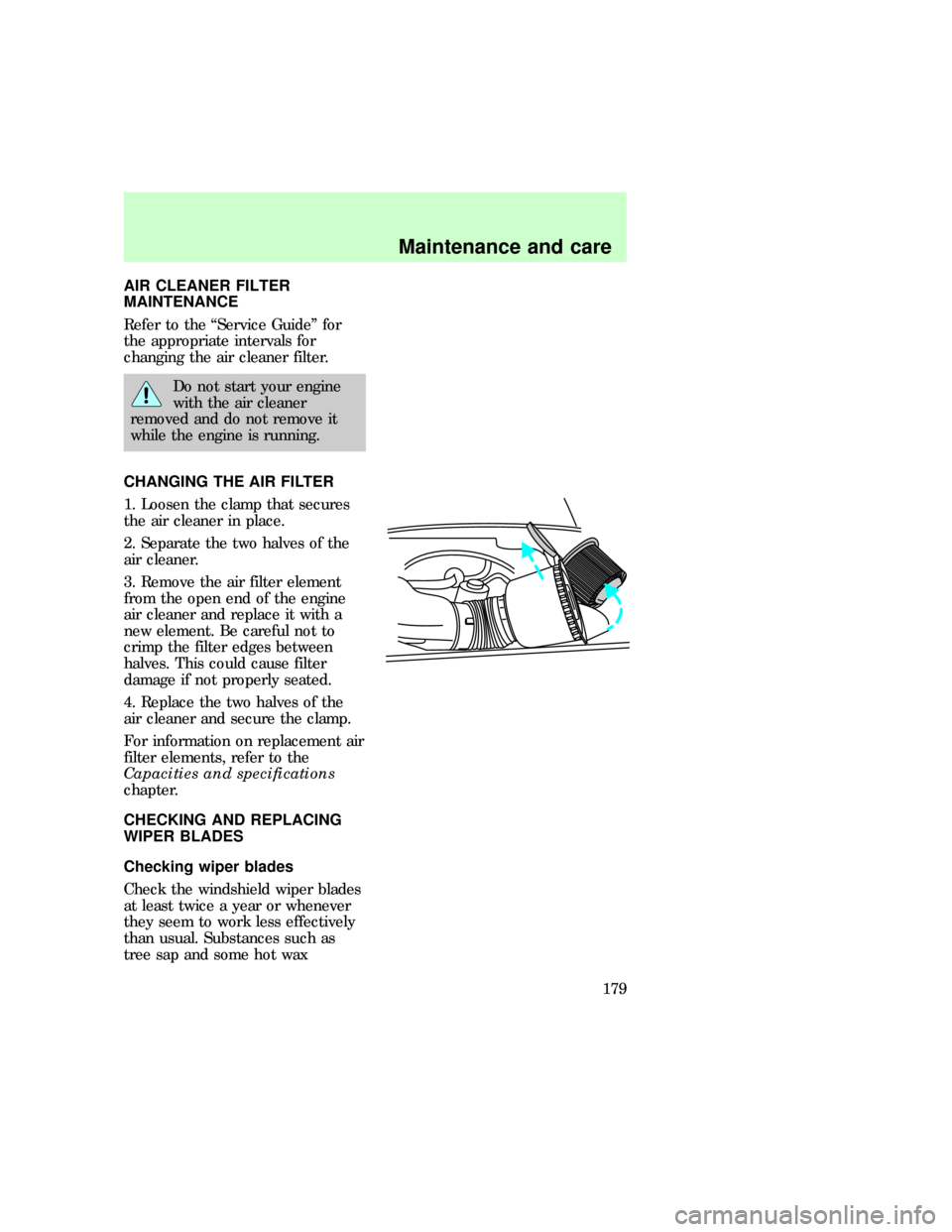
AIR CLEANER FILTER
MAINTENANCE
Refer to the ªService Guideº for
the appropriate intervals for
changing the air cleaner filter.
Do not start your engine
with the air cleaner
removed and do not remove it
while the engine is running.
CHANGING THE AIR FILTER
1. Loosen the clamp that secures
the air cleaner in place.
2. Separate the two halves of the
air cleaner.
3. Remove the air filter element
from the open end of the engine
air cleaner and replace it with a
new element. Be careful not to
crimp the filter edges between
halves. This could cause filter
damage if not properly seated.
4. Replace the two halves of the
air cleaner and secure the clamp.
For information on replacement air
filter elements, refer to the
Capacities and specifications
chapter.
CHECKING AND REPLACING
WIPER BLADES
Checking wiper blades
Check the windshield wiper blades
at least twice a year or whenever
they seem to work less effectively
than usual. Substances such as
tree sap and some hot wax
exd_changing_air_filter
exd_wiper
exd_checking_wipers
Maintenance and care
179
Page 179 of 224
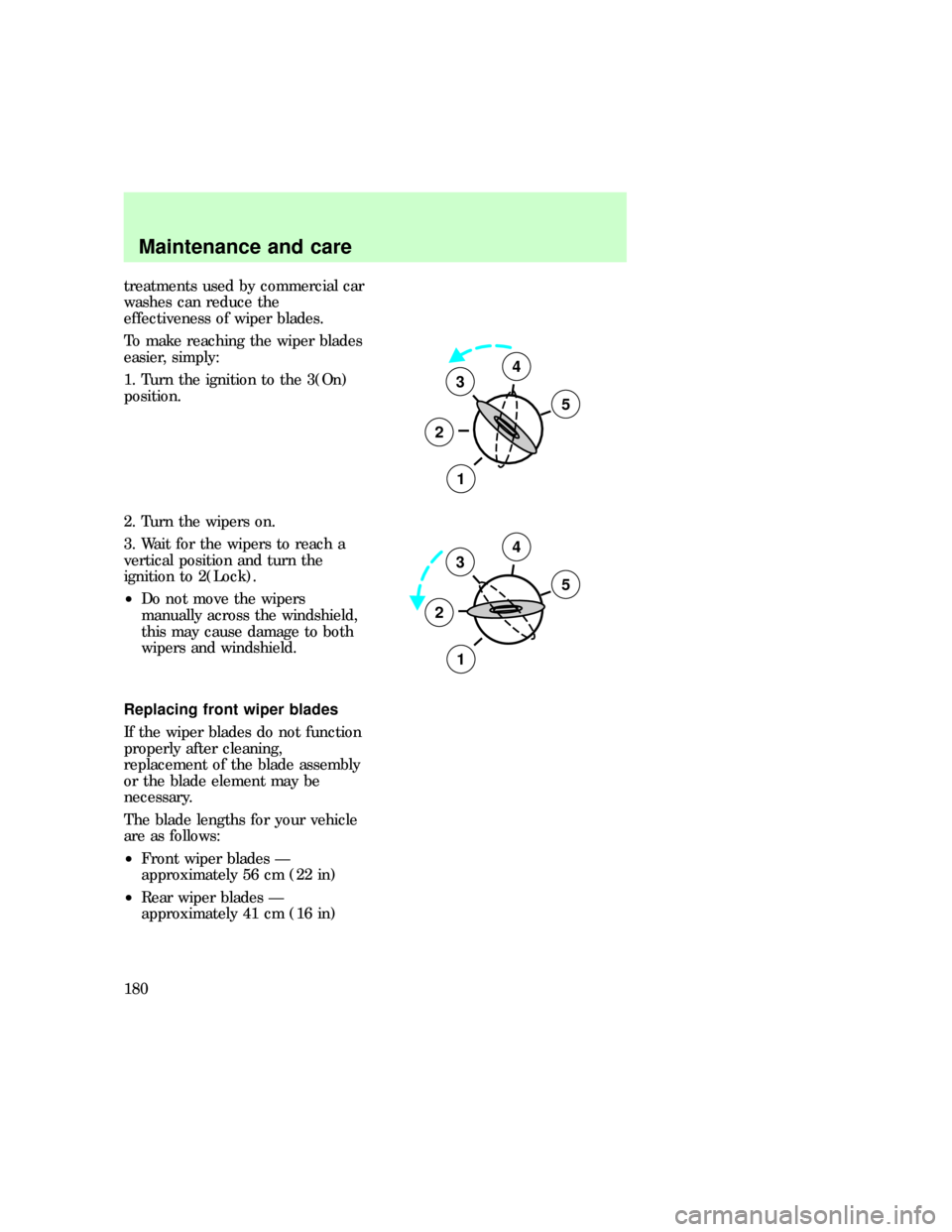
treatments used by commercial car
washes can reduce the
effectiveness of wiper blades.
To make reaching the wiper blades
easier, simply:
1. Turn the ignition to the 3(On)
position.
2. Turn the wipers on.
3. Wait for the wipers to reach a
vertical position and turn the
ignition to 2(Lock).
²Do not move the wipers
manually across the windshield,
this may cause damage to both
wipers and windshield.
Replacing front wiper blades
If the wiper blades do not function
properly after cleaning,
replacement of the blade assembly
or the blade element may be
necessary.
The blade lengths for your vehicle
are as follows:
²Front wiper blades Ð
approximately 56 cm (22 in)
²Rear wiper blades Ð
approximately 41 cm (16 in)
3
2
1
5
4
3
2
1
5
4
exd_replacing_wiper_blades
Maintenance and care
180
Page 180 of 224
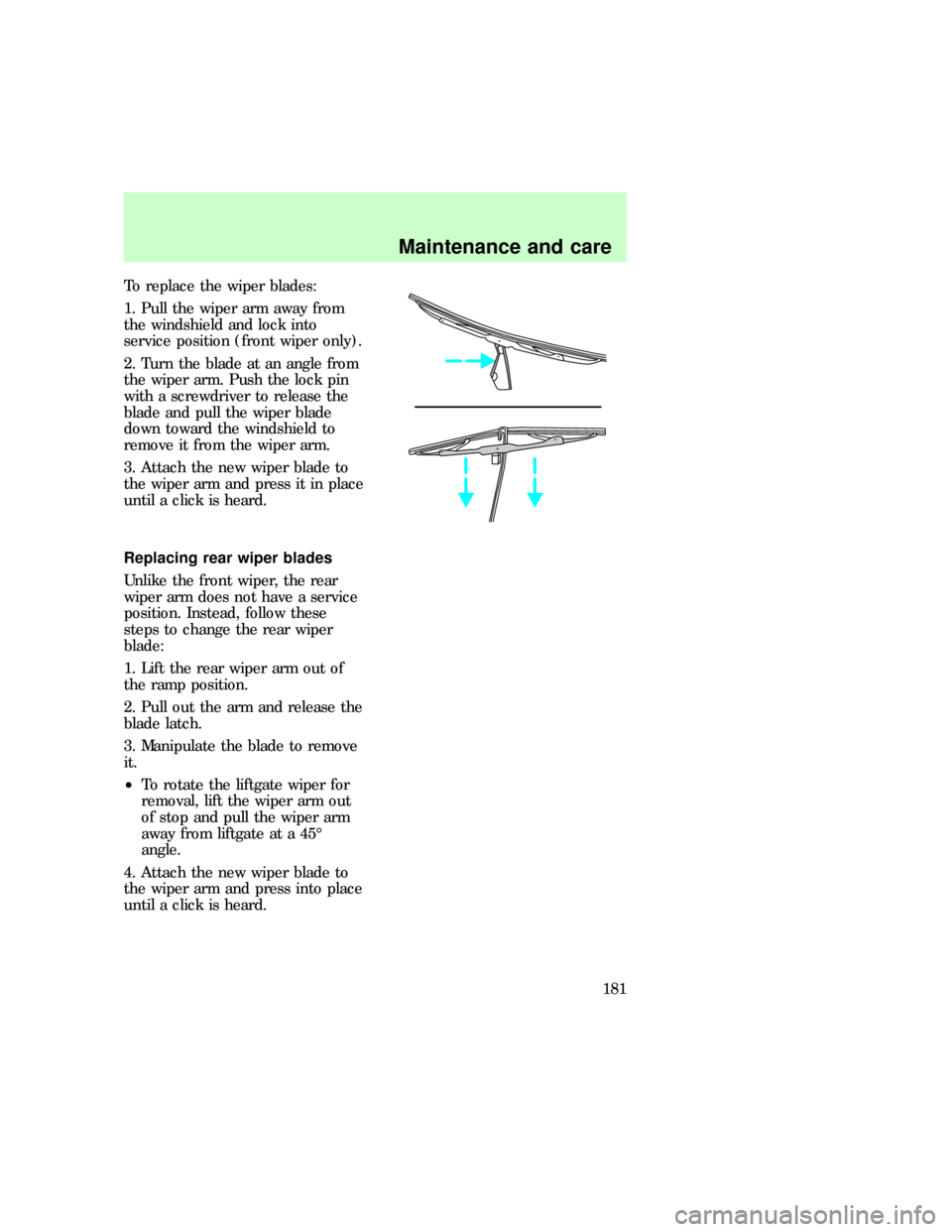
To replace the wiper blades:
1. Pull the wiper arm away from
the windshield and lock into
service position (front wiper only).
2. Turn the blade at an angle from
the wiper arm. Push the lock pin
with a screwdriver to release the
blade and pull the wiper blade
down toward the windshield to
remove it from the wiper arm.
3. Attach the new wiper blade to
the wiper arm and press it in place
until a click is heard.
Replacing rear wiper blades
Unlike the front wiper, the rear
wiper arm does not have a service
position. Instead, follow these
steps to change the rear wiper
blade:
1. Lift the rear wiper arm out of
the ramp position.
2. Pull out the arm and release the
blade latch.
3. Manipulate the blade to remove
it.
²To rotate the liftgate wiper for
removal, lift the wiper arm out
of stop and pull the wiper arm
away from liftgate at a 45É
angle.
4. Attach the new wiper blade to
the wiper arm and press into place
until a click is heard.
exd_rear_wiper_replace
exd_maint-tires
Maintenance and care
181